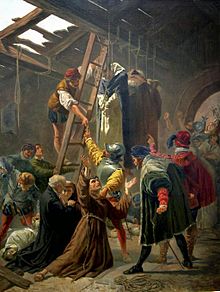|
Martyrs of Gorkum
 The Martyrs of Gorkum (Dutch: Martelaren van Gorcum) were a group of 19 Dutch Catholic clerics, secular and religious, who were hanged on 9 July 1572 in the town of Brielle by militant Dutch Calvinists during the 16th-century religious wars—specifically, the Dutch Revolt against Spanish rule, which developed into the Eighty Years' War. EventsIn the first half of the 16th century, various forms of Protestantism—particularly, Lutheranism and Calvinism—were spreading through Western Europe. In the Low Countries, then under the rule of Spain, Emperor Charles V and his son King Philip II instituted a systematic campaign to root out the new religious movements, which resulted in political resentment towards the authorities, including the Catholic Church. Inhabitants of the northern Netherlands who were primarily Protestant began to turn against the Catholic priests and monastics present.[2] By 1572 the Netherlands were in open revolt against Spanish rule, while in the internal rivalry among the Protestant denominations, Calvinism managed to suppress Lutheranism. On 1 April of the next year, Calvinist forces and a rebel group called the Watergeuzen (Sea Beggars) captured Brielle (Den Briel) and later Vlissingen (Flushing).[3] In June, Dordrecht and Gorkum fell, and at the latter the rebels captured nine Franciscan priests: Nicholas Pieck, guardian of Gorkum; Hieronymus of Weert, vicar; Theodorus van der Eem of Amersfoort; Nicasius Janssen of Heeze; Willehad of Denmark; Godefried of Mervel; Antonius of Weert; Antonius of Hoornaer, and Franciscus de Roye of Brussels. To these were added two lay brothers from the same friary, Petrus of Assche and Cornelius of Wijk bij Duurstede. At almost the same time the Calvinists arrested the parish priest of Gorkum, Leonardus Vechel of 's-Hertogenbosch, and his assistant.[3] Also imprisoned were Godefried van Duynsen of Gorkum, a priest in his native city, and Joannes Lenartz of Oisterwijk, a Canon Regular from a nearby priory and spiritual director for the monastery of Augustinian nuns in Gorkum. To these fifteen were later added four more companions: Joannes van Hoornaer (alias known as John of Cologne), a Dominican of the Cologne province and parish priest not far from Gorkum, who when apprised of the incarceration of the clergy of Gorkum hastened to the city in order to administer the sacraments to them and was seized and imprisoned with the rest; Jacobus Lacops of Oudenaar, a Norbertine, who became a curate in Monster, South Holland; Adrianus Janssen of Hilvarenbeek, a Premonstratensian canon and at one time parish priest in Monster, who was sent to Brielle with Jacobus Lacops. Last was Andreas Wouters of Heynoord.[3]  In prison at Gorkum (from 26 June to 6 July 1572), the first 15 prisoners were transferred to Brielle, arriving there on 8 July.[4] On their way to Dordrecht they were exhibited for money to the curious. The following day, William de la Marck, Lord of Lumey, commander of the Gueux de mer, had them interrogated and ordered a disputation. In the meantime, four others arrived. It was demanded of each that he abandon his belief in the Transubstantiation, the doctrine of the real presence of Christ in the Blessed Sacrament, as well as the belief in the Papal supremacy. All remained firm in their faith. Meanwhile, there came a letter from the Prince of Orange, William the Silent, which enjoined all those in authority to leave priests and religious unmolested. Despite this call, on 9 July, they were hanged in a turfshed.[3] VenerationA shrub bearing 19 white flowers is said to have sprung up at the site of their martyrdom. Many miracles have since been attributed to the intercession of the Gorkum Martyrs, especially the curing of hernias.[4] The beatification of the martyrs took place on 14 November 1675, and their canonization on 29 June 1867.[1][5] Their elevation to sainthood, which took place on the Feast of Saints Peter and Paul, was part of grand celebrations marking 1,800 years since the traditional year for the martyrdom of the two apostles in Rome.[6] For many years the place of their martyrdom in Brielle has been the scene of numerous pilgrimages and processions. The reliquary of their remains is now enshrined in Saint Nicholas Church, Brussels. The 19 martyrsThere were 11 Franciscan friars or Minderbroeders ('friars minor'), one Dominican friar or Predikheer, two Norbertine canons regular and a local canon regular, or witheren and five wereldheren ('secular clergy'). The 19 put to death on 9 July 1572 were:[3][7]
See alsoReferences
External links
|
||||||||||||||||||||||||
